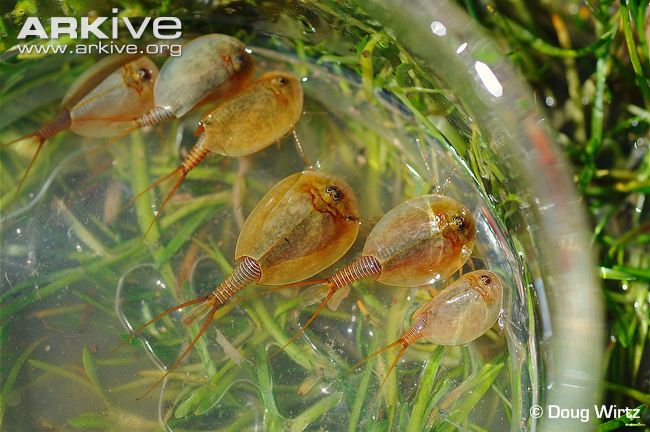Spring is the time of year when California’s vernal pools are the busiest. There are abundant small crustaceans living out their short lives in these seasonal wetlands. One, listed as endangered, is the Vernal Pool Tadpole Shrimp– Lepidurus packardi.
Vernal Pool Tadpole Shrimp can grow up to 5 cm long. They have a shield-like cover called a carapace and can be mottled olive-green, brown or gray in color.
Fossilized Tadpole Shrimp that lived millions of years ago look almost exactly like the ones we see today. The shrimp lived on Earth before there were fish and have never evolved defenses against fish predators. So, like Fairy Shrimp, Tadpole Shrimp now can live only where fish do not – in temporary pools.
Female Tadpole Shrimp produce hundreds of drought-tolerant encysted eggs which are deposited in the mud of the pool bottom. When it rains some of the cysts will hatch. Others may not hatch for many years. The cysts will rest there as the vernal pool evaporates and the bottom becomes hot and dry.
These crustaceans are one of the largest invertebrate morsels an animal can find for dinner in a vernal pool. They are eaten by wading birds such as egrets and herons and migratory waterfowl. Frogs eat them too.
Vernal Pool Tadpole Shrimp burrow or creep along the muddy bottom of the vernal pools. They are very aggressive omnivores, eating algae, bacteria, protozoa, rotifers, aquatic earthworms, insects, Fairy Shrimp, frog eggs and tadpoles.
Lepidurus packardi is listed as an endangered species. It is restricted to the Central Valley and the San Francisco Bay area and occurs only in certain vernal pools. Due to its very limited range and the continuing loss of vernal pools due to new development and agriculture, Vernal Pool Tadpole Shrimp are endangered. A species is listed as endangered when protection is needed to prevent the species from becoming extinct in the near future.
Inside Magazine has recently published an article about vernal pools by Dr. Amy Rogers. Read about vernal pools and Splash, Sacramento’s education program to help children understand the world of nature.

